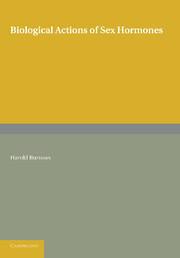Book contents
- Frontmatter
- CONTENTS
- PREFACE
- PART I GONADOTROPHINS
- PART II GONADAL HORMONES
- PART III ANDROGENS
- PART IV OESTROGENS
- CHAPTER XI Oestrogens
- CHAPTER XII The Action of Oestrogen on the Embryonic Gonads. and Miillerian and Wolffian Systems
- CHAPTER XIII The Action of Oestrogen on the Anterior Lobe of the Pituitary, and on the Gonads after their Differentiation
- CHAPTER XIV The Action of Oestrogen on the Accessory Genital Organs after their Differentiation, with a special reference to inguinal hernia
- CHAPTER XV The Action of Oestrogen on the Accessory Genital Organs
- CHAPTER XVI The Action of Oestrogen on the Accessory Genital Organs
- CHAPTER XVII The Effects of Oestrogen on the Mamma
- CHAPTER XVIII Factors in the Causation of Mammary Cancer
- CHAPTER XIX The Effects of Oestrogen on Connective Tissues and Skin
- CHAPTER XX The Actions of Oestrogen on organs other than those considered in earlier chapters
- PART V PROGESTINS
- PART VI SEX HORMONES OF THE ADRENAL CORTEX
- APPENDIX
- REFERENCES
- GLOSSARY
- INDEX
CHAPTER XVIII - Factors in the Causation of Mammary Cancer
from PART IV - OESTROGENS
Published online by Cambridge University Press: 05 June 2016
- Frontmatter
- CONTENTS
- PREFACE
- PART I GONADOTROPHINS
- PART II GONADAL HORMONES
- PART III ANDROGENS
- PART IV OESTROGENS
- CHAPTER XI Oestrogens
- CHAPTER XII The Action of Oestrogen on the Embryonic Gonads. and Miillerian and Wolffian Systems
- CHAPTER XIII The Action of Oestrogen on the Anterior Lobe of the Pituitary, and on the Gonads after their Differentiation
- CHAPTER XIV The Action of Oestrogen on the Accessory Genital Organs after their Differentiation, with a special reference to inguinal hernia
- CHAPTER XV The Action of Oestrogen on the Accessory Genital Organs
- CHAPTER XVI The Action of Oestrogen on the Accessory Genital Organs
- CHAPTER XVII The Effects of Oestrogen on the Mamma
- CHAPTER XVIII Factors in the Causation of Mammary Cancer
- CHAPTER XIX The Effects of Oestrogen on Connective Tissues and Skin
- CHAPTER XX The Actions of Oestrogen on organs other than those considered in earlier chapters
- PART V PROGESTINS
- PART VI SEX HORMONES OF THE ADRENAL CORTEX
- APPENDIX
- REFERENCES
- GLOSSARY
- INDEX
Summary
The subsequent discussion may be easier to follow if it is preceded by a statement of what appear, from experiments on animals, to be the principal causes of mammary cancer. They are as follows:
I. Oestrogen.
II. Hereditary Factors: (a) Genie; (b) Nongenic.
III. Subsidiary Factors.
The Role of Oestrogen in Mammary Cancer
(a) The influence of the ovary. Long before the identification of oestrone the ovary was thought to be an agent in the development of mammary cancer. In 1896 Sir George Beatson stated that ‘we must look in the female to the ovaries as the seat of the exciting cause of carcinoma, certainly in the mamma, in all probability of the female organs generally’. Beatson's views on the causative influence of the ovaries were confirmed by experiments in the laboratory. Lathrop & Leo Loeb (1916), using female mice of several different strains, found that removal of the ovaries, if carried out before the age of 6 months, led to a pronounced decrease in the incidence of cancer of the breast in these animals, although it did not entirely prevent it. In the few cases in which cancer arose in spayed female mice, it appeared later in life than in non-spayed mice of the same strain. Spaying mice above the age of 6 months did not have any pronounced effect in preventing mammary cancer. In a second paper (1919) Loeb showed, with greater precision than before, a contrast between the results of early and late spaying. If the ovaries were removed from mice between the ages of 3 and 5 months, cancer of the mamma was almost entirely prevented. If the spaying was done between the 5th and the 7th months, the cancer rate was diminished and when cancer did appear it was at a later age on the average than in nonspayed mice. Removal of the ovaries after the 8th month of life had no appreciable effect in reducing the incidence of mammary cancer.
Cori (1927) followed up Loeb's investigations. He removed the ovaries from mice belonging to a strain in which 78 per cent of the females suffered from spontaneous mammary carcinoma. In forty-nine of these mice which had been spayed at ages varying from 2 to 6 months, and which lived to 19 months or more, mammary cancer developed in five only.
- Type
- Chapter
- Information
- Biological Actions of Sex Hormones , pp. 348 - 367Publisher: Cambridge University PressPrint publication year: 2013

